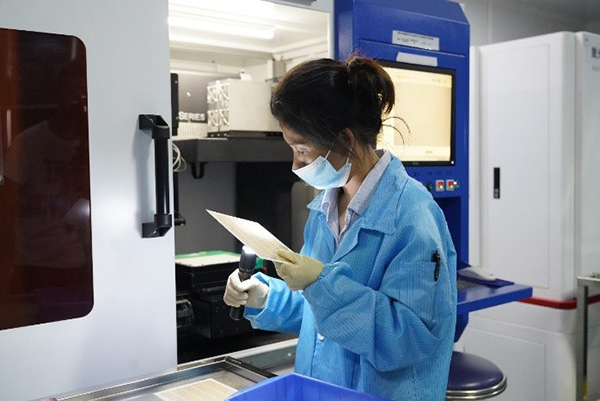Laser Cutting or Water Saw Cutting? How To Choose the Best Cutting Solution for Ceramic Circuit Boards
Ceramic circuit boards with the popularity of new energy vehicles, more and more people are aware of the excellent performance of ceramic circuit boards and the demand is increasing. Compared with traditional fiberglass boards, the substrate of ceramic circuit boards has the advantage of high mechanical strength, better high-temperature resistance, and thermal conductivity. In addition, ceramic circuit boards have good dimensional stability and chemical stability. However, ceramic circuit boards also have many disadvantages, such as higher cost, difficulty in processing, and high interface stress between the conductive layer and the substrate. Therefore, when processing ceramic circuit boards, it is necessary to choose an appropriate cutting method to ensure the quality and performance of the product. Currently commonly used cutting methods include laser cutting and waterjet cutting, each of which has different advantages and disadvantages, as follows:
Laser Cutting
Laser cutting uses a focused high-power density laser beam to irradiate the workpiece, causing the irradiated material to quickly melt, vaporize, ablate, or reach the ignition point. At the same time, the molten material is blown away by a high-speed airflow coaxial with the beam, thereby achieving the purpose of cutting the workpiece. Cut open. Laser cutting is one of the thermal cutting methods.

The advantages of ceramic PCB laser cutting are:
Ⅰ: The cutting speed is fast, the efficiency is high, and automatic operation can be realized.
Ⅱ: High cutting accuracy, smooth cuts, and no burrs.
Ⅲ: It has a wide cutting range and can cut metals, non-metals, composite materials, and other materials.
Ⅳ: It does not touch the workpiece surface during cutting and will not cause mechanical deformation or damage.
Ⅴ: Cutting requires less cleaning and produces a small amount of waste in the form of dust.
The disadvantages of ceramic substrate laser cutting are:
Ⅰ: The cutting cost is high, the equipment investment is large, and the operation and maintenance costs are high.
Ⅱ: It is a thermal cutting, which will produce a certain heat-affected zone (HAZ) on the material, which may lead to changes or losses in material properties.
Ⅲ: The cutting effect is not ideal for some materials (such as aluminum, copper, and other non-ferrous metals) or materials with large thicknesses, and problems such as cracks, oxidation, discoloration, and blackening may occur.
Ⅳ: Will produce a certain degree of light pollution and metal vapor pollution.
Water Saw Cutting
When water saw cutting, the spindle drives the blade to rotate at high speed to achieve high rigidity in removing material and achieving cutting. Since the blade has a certain thickness, the score line needs to be wide. The minimum cutting line width of the diamond scribing knife is 25-35um. Cutting wafers of different materials and thicknesses requires different tools. During the rotary abrasive scribing process, deionized water must be used to cool the blades and remove silicon slag fragments produced after cutting. So it’s called water saw cutting
The advantages of water saw cutting:
• Low cutting cost, small equipment investment, low operation and maintenance costs.
• It is cold cutting, which does not produce a heat-affected zone on the material and maintains the original performance and characteristics of the material.
• There are no requirements on material characteristics and thickness, any material can be cut, and the cutting thickness can reach 300mm5.
• Will not produce any harmful substances or pollution, safe and environmentally friendly.
The disadvantages of water saw cutting:
• The cutting speed is slower and less efficient than laser cutting.
• The cutting accuracy is lower than that of laser cutting, the cuts are not smooth enough and may have burrs.
• The cutting process requires a large amount of water and abrasives, resulting in a certain amount of waste and cleanup.
• Grinding waste may be toxic and require special handling.
Summarize
Compare Results |
Laser Cutting |
Water Saw Cutting |
|
Side Comparison Photo |
|
|
|
Benefit |
1. Can perform profile cutting and pre-cutting (V-CUT): 2. Can S line cutting 3. High efficiency; low cost 4. non-contact cutting requires no tool replacement, and the cutting process has low noise, small vibration, and no pollution. |
1. High cutting precision and the cutting tolerance of outer dimensions are within 0.05mm; 2. Cutting edge and smooth surface |
|
Harm |
1. There are laser sintering marks on the cutting edge and surface. The edges are rough and there is sputter residue on the surface; 2. The cutting tolerance of the outer dimensions is not as high as that of the water jet Cutting tolerance within 0.1mm; 3. It is easy to have quality problems such as jumpers. |
1. The cutting edges are prone to chipping and quality problems. 2. The process is complex and the cost is high 3. It can only be used for straight cutting, not curved cutting. |
|
application |
Ceramic substrate shape cutting, curve cutting, laser cutting Light drilling, etc. |
Epistar, diodes, ceramic substrates (high precision) |
In summary, laser cutting and water saw cutting have their own advantages. The specific selection needs to be comprehensively considered based on factors such as product design requirements, budget, material characteristics, etc. Generally speaking, if you have high requirements for cutting speed, precision, and smoothness, and the material can withstand a certain heat-affected zone, you can choose laser cutting; if you have high requirements for cutting cost, environmental protection, and material performance maintenance, and the material thickness is relatively thick For items that are large or difficult to cut with a laser, waterjet cutting can be an option. If you want to know more about ceramic circuit boards, you can check out our previous blogs. Thanks for reading and have a nice day!






















































 HOME
HOME









